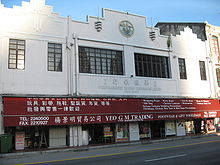- Oversea-Chinese Banking Corporation
-
Oversea-Chinese Banking Corporation Limited 
Type Public (SGX: O39) Founded 1932 Headquarters Singapore Area served South East Asia Key people Cheong Choong Kong, Chairman
David Conner, CEOProducts Consumer banking
Corporate banking
Investment banking
Global wealth management
Asset management
InsuranceNet income S$1,962 million (FY2009) Total assets S$224 billion (Sept 2010) Total equity S$20 billion Website www.ocbc.com The Oversea-Chinese Banking Corporation Limited (SGX: O39) (Simplified Chinese: 华侨银行有限公司), abbreviated as OCBC Bank (华侨银行), is a publicly listed financial services organisation with its head office in Singapore. OCBC Bank is one of Singapore's leading local banks, with group assets of more than 224 billion SGD. It has one of the highest bank credit ratings in the region. As of November 2010, the bank is the largest local bank in Singapore by market capitalisation.[1] However, it is the smallest local bank in Singapore by global presence.
The bank's global network has grown to comprise more than 530 branches with representative offices in 15 countries and territories, including Singapore, Malaysia, Indonesia and a few small branches in China, Hong Kong SAR, Japan, Australia, UK and USA. The branches include the 411 branches and offices in Indonesia operated by its subsidiary, Bank OCBC NISP.
Contents
History
OCBC Bank was founded out of the Great Depression with the merger of three banks in 1932 - the Chinese Commercial Bank (1912), the Ho Hong Bank (1917) and the Oversea-Chinese Bank (1919). The bank's name is often mistakenly thought to be incorrectly spelled, but is in fact a predominantly British usage of the word more commonly spelled as "overseas".
The combined entity prospered under the management of local business and community leaders, notably Dato Lee Kong Chian (1938–1964), Tan Sri Tan Chin Tuan (1966–1983) and Mr Lee Choon Seng (acting Chairman during the Occupation), eventually becoming one of the largest banks in Singapore and Malaysia. In 1942 all the local banks in Singapore closed briefly during the early days of the Japanese Occupation. By April 1942 most, including OCBC, had reopened. OCBC Bank was one of only four foreign banks to have branches in China in the 1950s.
OCBC were the first to introduce the night safe system in Singapore and Malaya (in 1948), which allowed customers to deposit cash and valuables after business hours. In 1958 they were also the first to establish a mobile bank, targeting customers living in suburban areas. Despite its strength and history of innovation, the bank was criticized for not expanding fast enough to meet the needs of the post-war Chinese business community, especially in the smaller towns of Malaya. One of the critics was Tan Sri Khoo Teck Puat, who subsequent resigned to set up Malayan Banking.
OCBC were noted as one of the pioneers in the Asian dollar market in the 1960s. By 1970, the bank's total resources exceeded 1 billion SGD, making OCBC, then, the largest financial institution with the biggest deposit base in Singapore.
In 1972, the bank acquired Four Seas Communications Bank, the oldest surviving bank in Singapore. Four Seas Communications Bank had been founded in 1906 under the name Sze Hai Tong Bank to serve the Teochew community. The bank had branches in Bangkok, where it became the first Chinese bank there when it opened its branch in 1909, and in Hong Kong.
Recent key corporate milestones
- 2000: Acquired Bank of Singapore
- 2001: Acquired Keppel Capital Holdings
- 2003: Merger of OCBC Finance with OCBC Bank
- 2004:
Mar-Proposed acquisition of 22.5% stake in PT Bank NISP, Indonesia, Apr-Announced intention to make S$2.8 billion offer for Great Eastern Holdings, Jun-Achieved 81.1% shareholding in Great Eastern Holdings (GEH), Dec-Announced intention to increase shareholding in PT Bank NISP to 51%
- 2005:
Mar-Official opening of e2 Power’s Cyberjaya Office, Apr-Bank NISP becomes a subsidiary of OCBC Bank, Collaboration with Bank NISP to launch joint ATM cash withdrawal service, Jun-Official opening of OCBC Bank’s new corporate HQ in Kuala Lumpur, raised stake in Bank NISP to 70.62%, and announced merger of asset management operations of OAM with Straits Lion Asset Management, Jul-Opened off-shore branch in Brunei
- 2006:
Jan-Announced intention to take a 12.2% stake in China’s Ningbo Commercial Bank, Mar-Announced intention to acquire 10% stake in Vietnam’s VP Bank, Jun-Completed acquisition of a 12.2% stake in China’s Ningbo Commercial Bank, Aug-Achieved 87.1% shareholding in GEH following voluntary cash offer, Aug-Completed acquisition of a 10% stake in Vietnam’s VP Bank,
- 2007:
Aug-Commencement of business of OCBC China, Nov-Received Bank Negara Malaysia’s approval to set up Islamic banking subsidiary,
- 2008:
Jan-Announced conditional takeover offer of PacificMas Berhad, Apr-Achieved 67% shareholding in PacificMas Berhad, Dec-Commencement of business of Islamic banking subsidiary, OCBC Al-Amin, Indonesian subsidiary, Bank NISP, is renamed Bank OCBC NISP
- 2009:
Oct-Announced intention to acquire ING Asia Private Bank Ltd & its affiliated entities
- 2010:
Completed acquisition of ING Asia Private Bank Ltd & its subsidiaries. With the acquisition, ING Asia Private Bank Ltd became a wholly owned subsidiary of OCBC Bank, and took on the name “Bank of Singapore Limited”. The existing Bank of Singapore Limited, which is another wholly owned subsidiary of OCBC Bank, changed its name to Singapore Island Bank Limited on the same day.
Subsidiaries
OCBC Securities
OCBC Securities Private Limited is a wholly owned subsidiary of OCBC Bank, and is a member of the Singapore Exchange Securities Trading Limited (SGX-ST) and the Singapore Exchange Derivatives Trading Limited (SGX-DT). It is one of the leading stock and futures broking firms in Singapore providing full brokerage services for equities and derivatives trading.
Great Eastern Holdings
Great Eastern Holdings is a subsidiary of OCBC Bank. Great Eastern Holdings is the oldest and most established life insurance group in Singapore and Malaysia. With $53.1 billion in assets and 3.8 million policyholders as at 30 September 2010, it has two successful distribution channels - the tied agency force and bancassurance. The company also operates in China, Indonesia, Vietnam and Brunei. Great Eastern Holdings' asset management subsidiary, Lion Global Investors Limited, is one of the largest private sector asset management companies in Southeast Asia.
Lion Global Investors
Launched in September 2005 following the merger of the asset management arms of OCBC Bank and Great Eastern Holdings, Lion Global Investors Limited is one of the largest asset management companies in Singapore and Southeast Asia. With total assets under management of about S$29.4 billion as at 30 September 2010, Lion Global Investors offers a comprehensive suite of investment products covering all asset classes to statutory boards, educational institutions, public and private companies, charities, non-profit organizations and retail investors.
Bank of Singapore
Bank of Singapore, (formerly ING Asia Private Bank), is a wholly owned private banking subsidiary of OCBC Bank. It is the only dedicated private bank to be headquartered in Singapore. Rated Aa1 (equivalent to a Standard & Poor’s rating of AA+) with a stable outlook by Moody’s, Bank of Singapore offers a unique open-architecture product platform that enables it to offer best of breed products and services. It also has a proprietary research framework that provides clients with objective and independent advice. Currently, Bank of Singapore offers a complete suite of private wealth solutions that includes discretionary portfolio management, wealth planning, and immigration services. Bank of Singapore can also leverage on OCBC Bank’s extensive regional branch network and expertise in a broad array of specialist financial services.
With a branch in Hong Kong and offices in Manila and Dubai, Bank of Singapore serves high net worth individuals and wealthy families of China, Europe, Hong Kong, Indonesia, Japan, Korea, Malaysia, the Middle East, the Philippines, Singapore, Taiwan, Thailand and global Non-Resident Indians.
Acquisitions
Singapore Island Bank
Singapore Island Bank Limited is a full-licensed bank and a wholly owned subsidiary of OCBC Bank. Singapore Island Bank has S$100 million in capital, and is governed under the Banking Laws and Regulation in Singapore. It houses the division, finatiQ where finatiQ operates as an Internet bank.
Singapore Island Bank was formerly known as Bank of Singapore. On 29 January 2010, OCBC Bank completed its acquisition of ING Asia Private Bank and renamed it Bank of Singapore. At the same time, the bank that houses the division, finatiQ, changed its name to Singapore Island Bank to differentiate these two separate businesses. It was purely a name change for the former Bank of Singapore and the purpose was to avoid confusion.
Bank NISP
In 2004, OCBC Bank acquired a 22.5% stake in PT Bank NISP Tbk (“Bank NISP”), its joint-venture partner in PT OCBC Indonesia since 1996. Bank NISP’s business focus complements OCBC Bank’s strengths and target growth segments in the SME and consumer banking business. With the completion of this transaction, Bank NISP became an associate company of OCBC Bank. Bank NISP was ranked the 12th largest Indonesian bank by assets and had a network of 135 branches and offices and, over 3,000 shared ATMs.
In the same year, OCBC Bank purchased an additional 28.5% stake in Bank NISP, raising its shareholding in Bank NISP to a majority of 51%. OCBC Bank subsequently raised its stake to 70.62% in 2005. By 2008, it had increased its stake in Bank NISP to 74.73%. In 2008, Bank NISP changed its name to Bank OCBC NISP. At that point in time, Bank OCBC NISP’s network had expanded to over 360 branches and offices and more than 20,000 shared ATMs nationwide.
As of September 30, 2010, Bank OCBC NISP has total assets of Rp 40.2 trillion and serves customers through a network of 411 offices in 62 cities and 576 ATMs throughout Indonesia and also facilitates transactions in more than 37,500 ATMs (including ATM Bersama, Bank Central Asia, OCBC Bank in Singapore and BankCard in Malaysia) with the support of 5,995 employees.
Keppel Tat Lee Bank
In 2001, OCBC Bank was the first Singapore-based financial institution to make the move for consolidation in Singapore’s banking sector when it acquired Keppel Capital Holdings Ltd and all its subsidiaries, including Keppel TatLee Bank Limited, Keppel Securities Private Limited and Keppel TatLee Finance Limited. In 2002, OCBC Bank and Keppel TatLee Bank were operationally and legally integrated.
China’s Ningbo Commercial Bank
In 2006 the bank acquired a 12.2% stake in China’s Ningbo Commercial Bank.
Bank of Singapore Ltd
OCBC Bank completed its acquisition of ING Asia Private Bank Ltd & its subsidiaries on 29 January 2010. With the acquisition, ING Asia Private Bank Ltd became a wholly owned subsidiary of OCBC Bank, and took on the name “Bank of Singapore Limited”. The existing Bank of Singapore Limited, which is another wholly owned subsidiary of OCBC Bank, changed its name to Singapore Island Bank Limited on the same day.
Recognition
Bloomberg has ranked OCBC Bank as the world's strongest bank in May 2011.
The rating was based on these 5 criteria[2]:
- Tier 1 Capital-to-risk Weighted Assets
- Non-performing assets to total assets
- Loan-loss reserves to non-performing assets
- Deposits to funding and
- Efficiency (costs to revenue)
However, it must be noted that this ranking is purely on credit strength, and does not take into account the actual international market share, growth potential and international prestige of the bank relative to those in the major financial markets.
External links
- OCBC Group - official site
References
- ^ Jo-Ann Huang (12 November 2010). "OCBC Surpasses DBS To Become No 1 Bank In Singapore". Today (Singapore): p. B2.
- ^ Lee, Stella. "S'pore's OCBC ranked world's strongest bank by Bloomberg". ChannelNewAsia. http://www.channelnewsasia.com/stories/singaporebusinessnews/view/1127914/1/.html. Retrieved 11 May 2011.
Categories:- Companies listed on the Singapore Exchange
- Banks of India
- Banks of Bangladesh
- Companies of Singapore
- Companies established in 1932
Wikimedia Foundation. 2010.


